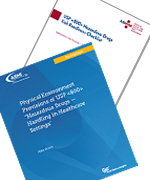

USP <800> Monograph and Risk Readiness Checklist Bundle
 The aim of USP ‹800› is to protect health care workers and patients from harm associated with exposure to hazardous drugs (HDs). According to the Centers for Disease Control and Prevention (CDC), eight million health care workers are potentially exposed to HDs every year. This exposure can occur with workers who are unaware of their exposure and in departments outside of the pharmacy. USP <800> was developed to define the quality standards for the handling of HDs and the proper environmental controls for compounding to protect health care workers and patients. Aspects of handling HDs covered in USP <800> where exposure can occur include receiving, transporting, storing, compounding, dispensing, administering, spills, cleaning and waste disposal. Entities that handle HDs must incorporate the standards in chapter <800> into their occupational safety plan. The plan’s health and safety management must, at a minimum, include:
The aim of USP ‹800› is to protect health care workers and patients from harm associated with exposure to hazardous drugs (HDs). According to the Centers for Disease Control and Prevention (CDC), eight million health care workers are potentially exposed to HDs every year. This exposure can occur with workers who are unaware of their exposure and in departments outside of the pharmacy. USP <800> was developed to define the quality standards for the handling of HDs and the proper environmental controls for compounding to protect health care workers and patients. Aspects of handling HDs covered in USP <800> where exposure can occur include receiving, transporting, storing, compounding, dispensing, administering, spills, cleaning and waste disposal. Entities that handle HDs must incorporate the standards in chapter <800> into their occupational safety plan. The plan’s health and safety management must, at a minimum, include:
- List of HDs
- Facility and engineering controls
- Competent personnel
- Safe work practices
- Proper use of appropriate Personal Protective Equipment (PPE)
- Policies for HD waste segregation and disposal
This American Society for Health Care Engineering (ASHE) monograph discusses the physical environment provisions of USP <800> and is primarily intended for the use of health care facility managers. The USP <800> Risk Readiness Checklist, created by the American Society for Health Care Risk Management (ASHRM), will assist users in identifying areas where opportunities exist to comply with USP <800> required standards.

